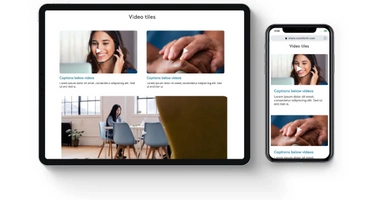If you’re looking to increase your brand’s reach via video, then it’s worth bearing in mind some video content best practices to help maximize the return from your investment.
Compared to text-based content, creating video content often requires more input in terms of production. It can, however, be used effectively in microsites in order to vary the presentation that customers receive, enhancing your video page design.
Long stretches of text have a habit of putting people to sleep (your sales team has probably already noticed this). Those who want to present bids and sales proposals, learning content or personalized recruitment pages in a more engaging fashion can make use of video content in addition to embedded audio and data elements.
The good news is that when it comes to video, there’s a whole world of data already at one’s fingertips. Popular video hosting and sharing sites such as YouTube have hundreds of millions of videos ready to be embedded. These can add that missing touch of motion and excitement to your microsites.
Nevertheless, many creators want to add original and company-branded videos into their microsites. In this blog, we’ll take a look at some of the standout advantages of video that are relevant for those creating microsites and provide some tips for how to do it well. We’ll also look at how to add video to your microsites, using our platform.
Create video content to boost engagement by leveraging human contact principles
Creating video content that showcases human contact boosts engagement. Clients often tell us that they want to increase their use of video in microsites because — intuitively — they feel that their buying audiences will forge a stronger connection with information that’s demonstrated through this medium.
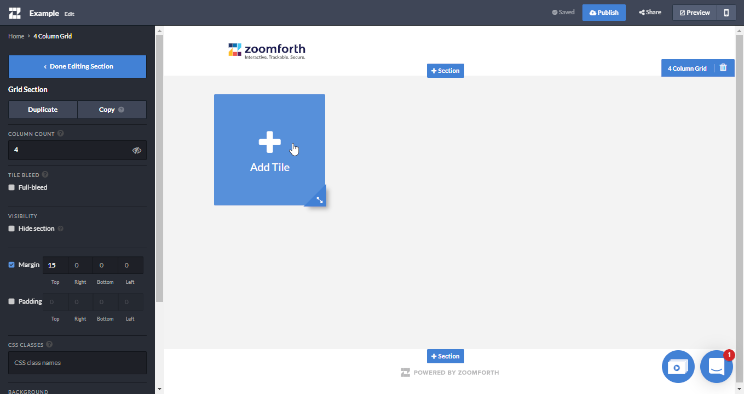
The good news is that science is here to say, “yes, that makes total sense.”
Here are some observations from Wistia, the video platform, to bear that out:
“The global pandemic has overwhelmingly impacted the amount of time people spend watching videos online — we saw an 85% increase in minutes watched on our platform in 2020. People watched 12.2 billion minutes of video last year — that’s 23,211 years worth of content!”
Humans tend to be curious about video content that contains other humans in it. While most Zoomforth users are leveraging the tool in order to drive connection with B2B buying audiences, it’s important to remember that B2B buyers are just people, doing a job. In other words, the same rules that govern social engagement are likely to apply in this context.
If you’re building out microsites for bid responses, then consider adding an introduction video showing the key stakeholders on your team who might be responsible for making the project a success. While getting to “e-know” your correspondents by email can help break the ice to an extent, many clients report that video introductions are more powerful in terms of building that sense of rapport and trust that can be difficult to create otherwise.
Stick to brand guidelines in video content
When planning your video content development, make sure that you stick to brand guidelines. Just because it’s video doesn’t mean that you don’t have to stick to the visual and brand guidelines that your communications team has laid down. They’re there to ensure that the brand is communicated in a consistent manner across formats. So in fact it’s especially important to use them at this juncture.
If your brand communication guidelines have set down a palette for internal use, then stick to that palette when drafting up transition slides and other still visuals to enhance the main video.
If your brand name is to be written in a certain font then make sure that that’s how it’s written in the videos you include in your microsites.
Consider the dress code for your video participants, as well as the backgrounds they are filmed against. Videos don’t need to be overproduced or super-polished, but they do need to convey your professionalism.
While you can definitely impress your prospects by showing that you’ve gone to the trouble of creating personalized videos for them, equally this isn’t a time to let your guard down and deviate from the type of brand that you’ve worked so hard to communicate through other channels.
Keep your video content accessible
Whether you’re using microsites to communicate bid proposals or personalized recruitment offers, it’s vital not to make any assumptions about who will be viewing the content and what limitations they might be dealing with.
Just as it’s best practice to add alt tags to still images on websites, it’s a good idea to make sure that you have a captions track added to every video that you produce and include in your microsites. This will make the video accessible even to those who have visual impairments.
A transcript is useful too. Not everybody is going to have the time or inclination to watch a full-length proposal video on the fly – or to want to watch that through video. Producing a machine-generated but hand-edited transcript of the video can make it easier to capture the attention of a larger pool of readers. Accessibility widens the audience as far as possible.
Keep your marketing videos short
While videos can impress and engage, you risk losing people if your videos aren’t short and snappy.
In its latest ‘State of Video’ report, Wistia observed that engagement starts to drop off at the 3-minute mark so aim for short and sweet, rather than lengthy explainer videos.
“Engagement tends to stay just at around 50% for the first three minutes and drops steadily after that mark.”
There are no hard and fast rules here, but we can offer some general recommendations:
- If you have a few points to cover in one video e.g. an overview of the solution you’re presenting for a bid, then consider breaking them up into several shorter videos. This will make it easy for those on the other end of the sales process to skip just to the video that impacts upon their role.
- Don’t go above the three minute limit unless there’s a definite need.
- Consider creating a summary version of your proposal as well as a longer video that dives into the detail by area. The summary version can be sent to the project’s executive sponsor while the individual teams can skip through the longer video to hone in on the aspect of the proposal that most directly concerns their work.
Four ways to use Zoomforth in your video strategy
To upload a video to your Zoomforth microsite from within our tool:
1. Upload a video from your desktop
- Add a new tile to a grid section
- Click on the “add” icon within the tile
- Click on Upload media
- You’ll be prompted to upload a video. You can either drag and drop a compatible file in from another window or you can use the file manager on your system.
- You can choose to have the video expand and play in an overlay or play inline.
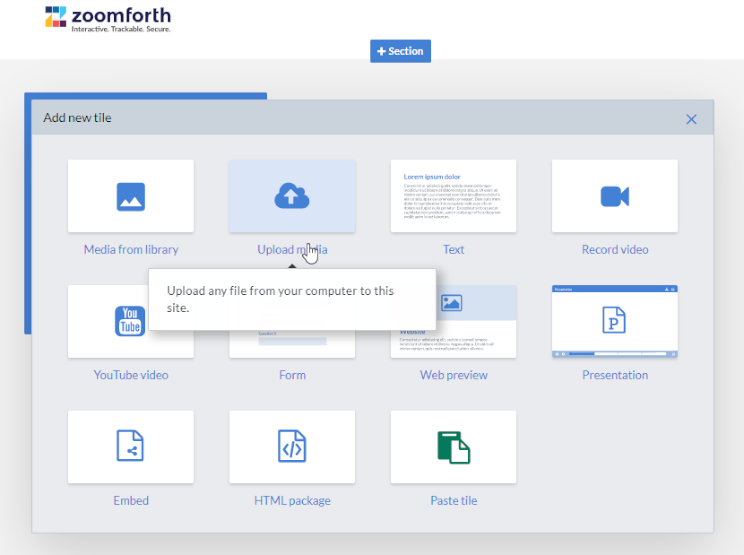
2. Embed a YouTube video
If you’d like to embed a video from YouTube, first double check that you’re not violating the usage license under which the video was shared. Then, click on the YouTube video option and copy the embed code. This will embed the video into your site.

3. Record a video on the fly
If you just want to include a short video introduction to your site, you can do that directly in the app. Simply select the ‘Record video’ option and talk! Once you’re done, the video will automatically load into your site.
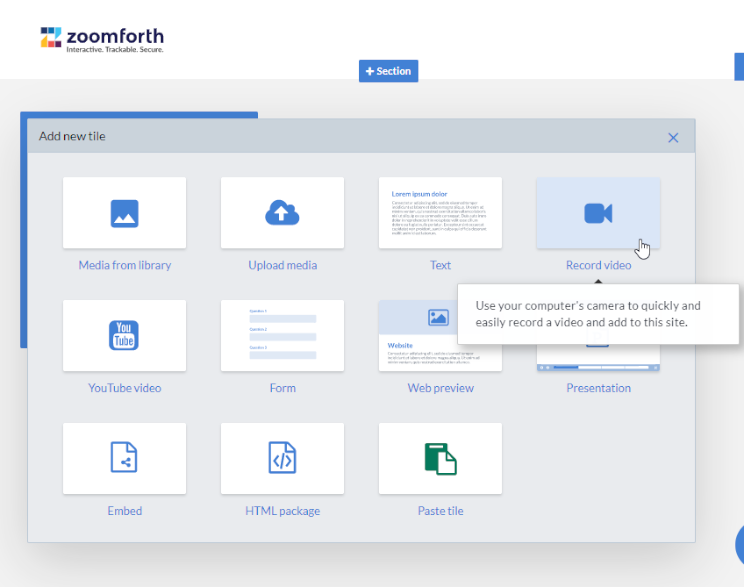
4. Add a video playlist
If you want to create a video playlist, first create a new section within your site’s page and then select ‘Video playlist’. This will allow you to add a playlist so the visitor can pick and choose which elements to view.
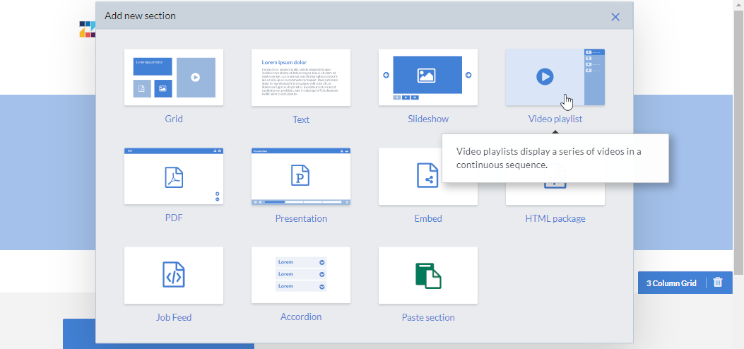
Make microsites more fun with engaging video content
For readers, videos widen the gap further between boring old PDF documents and something new and exciting. For that reason, getting creative with the type of media content that you leverage in microsites can give you a further edge over your competitors who are stuck in the static document era.
Use a few well placed videos to improve the engagement levels you see on your microsites. Just make sure that they accord with your brand communication guidelines, are of an appropriate length, and that you’re okay to use them. The results should speak for themselves.
Want to learn more? Join one of our free Design Skills Workshops here.
